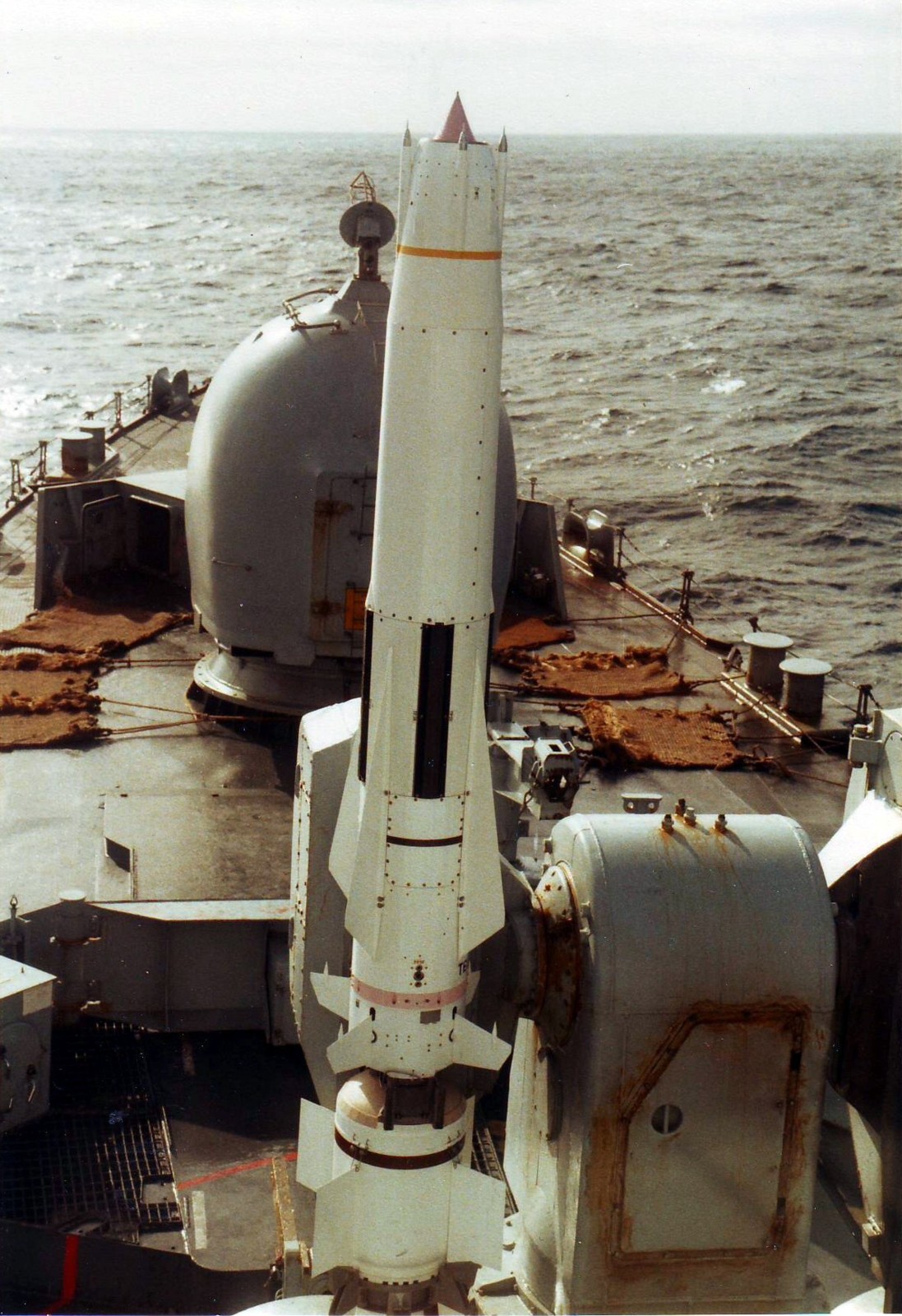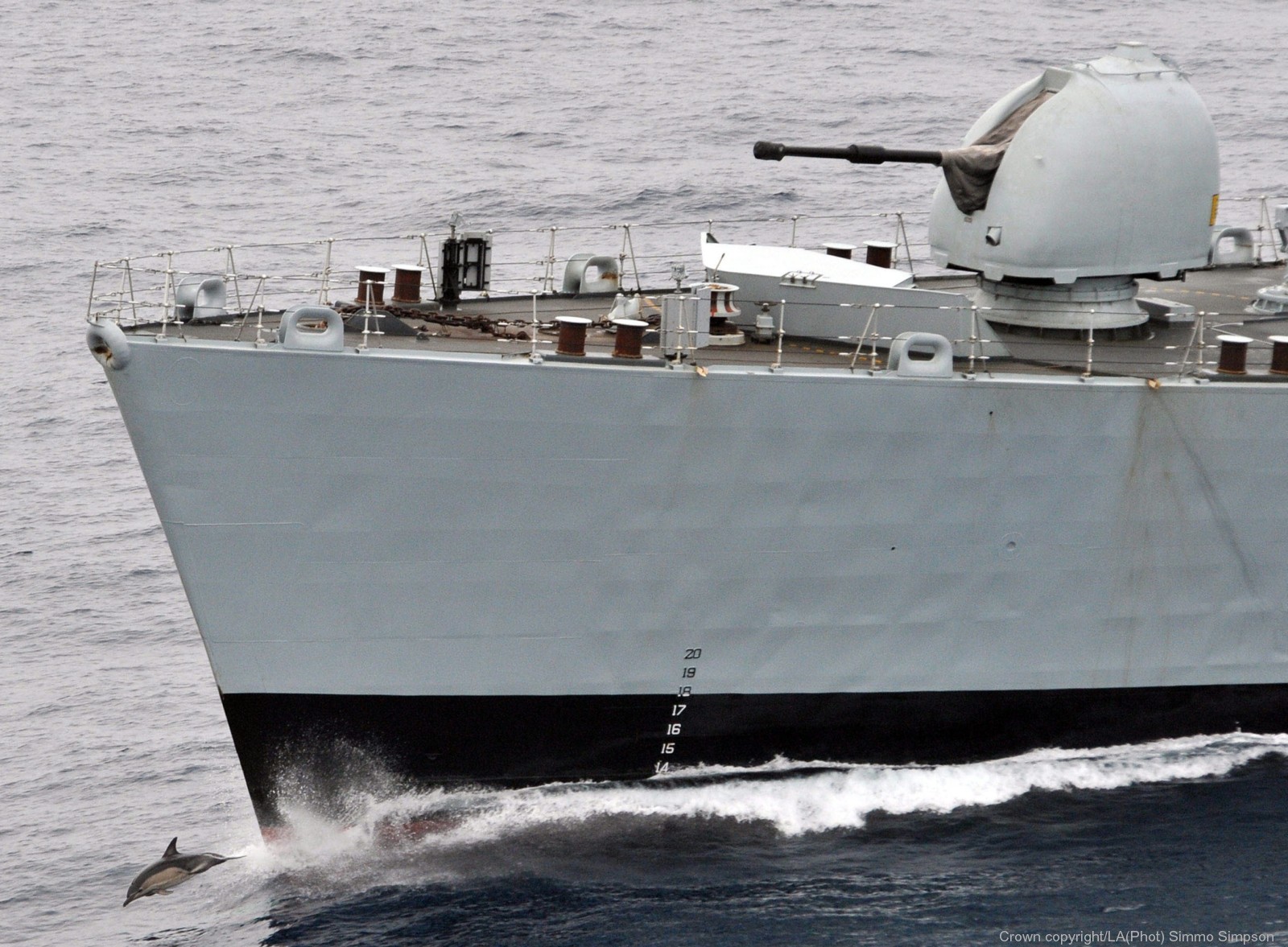|
|
|
HOME
|
US Navy -
ships
|
US Navy - air
units
|
USMC - air
units
|
International
Navies
|
Weapon Systems
|
Special Reports |
|
|
|
|
|
United Kingdom - Royal Navy Sheffield (Type 42) class Guided Missile Destroyer |
|
|
 |
|
|
| Ships: |
|
Batch 1: D 80 HMS Sheffield (1975) D 86 HMS Birmingham (1976) D 108 HMS Cardiff (1979) D 118 HMS Coventry (1978) D 87 HMS Newcastle (1977) D 88 HMS Glasgow (1978) Batch 2: D 89 HMS Exeter (1980) D 90 HMS Southampton (1981) D 91 HMS Nottingham (1983) D 92 HMS Liverpool (1982) Batch 3: D 95 HMS Manchester (1982) D 96 HMS Gloucester (1985) D 97 HMS Edinburgh (1985) D 98 HMS York (1985) |
| Specifications: |
|
Length:
Batch 1+2 = 125 meters (410 ft) / Batch 3 = 141 meters (463 ft)
Beam: Batch 1+2 = 14,3 meters (47 ft) / Batch 3 = 14,9 meters (49 ft) Draft: 4,2 meters (14 ft) keel / 5,8 meters (19 ft) propellers Displacement: Batch 1+2 = 4820 tons (full load) / Batch 3 = 5200 tons (full load) Speed: 30 knots (56 km/h), max. Range: 4200 NM (7800 km) at 13.8 knots (25,6 km/h) Complement: Batch 1, 2, 3 = 253, 274, 301 Propulsion: COGOG (combined gas or gas) 2 x Rolls-Royce Olympus TM3B gas turbines (50000 shp) 2 x Rolls-Royce Tyne RM1C gas turbines (5340 shp) 2 shafts, 2 propellers Armament: 1 x GWS-30 twin launcher for Sea Dart SAM missiles 1 x Mark 8 4.45 inch (113mm) gun 2 x Oerlikon/BMARC 20mm/L70 KBA guns 2 x Mk-15 Phalanx CIWS (later) 2 x triple torpedo tubes Aviation: flight deck and hangar for 1 helicopter (Westland Lynx) |
|
|
|
The Type 42 or Sheffield class, are light guided missile destroyers
used by the Royal Navy and the Argentine Navy (2 units). The first
ship of the class was ordered in 1968 and launched in 1971. Two of
the class (Sheffield and Coventry) were sunk in action during the
Falklands Conflict of 1982. The UK Royal Navy used this class of
destroyer for 38 years between 1975 and 2013. History: The class was designed in the late 1960s to provide fleet area air-defence. In total fourteen vessels were constructed in three batches. In addition to the Royal Navy ships, two more ships were built to the same specifications as the Batch 1 vessels for the Argentine Navy. Hércules was built in the UK and Santísima Trinidad in the AFNE Rio Santiago shipyard in Buenos Aires. Sheffield and Coventry were lost in the Falklands Conflict to enemy action. (This was the first conflict when surface warships of the same design have been on opposite sides since World War II, when four Flower-class corvettes built for France in 1939 were taken over by the Kriegsmarine in 1940.) The final ship of the class (Edinburgh) decommissioned on 6 June 2013. One Argentine Navy ship (Hércules) remains in service, the other vessel (Santísima Trinidad) sank whilst alongside in Puerto Belgrano Naval Base in early 2013. When the Type 82 air-defence destroyers were cancelled along with the proposed CVA-01 carrier by the Labour Government of 1966, the Type 42 was proposed as a lighter and cheaper design with similar capabilities to the Type 82. The class is fitted with the GWS30 Sea Dart surface-to-air missile first deployed on the sole Type 82 destroyer, Bristol. The Type 42s were also given a flight deck and hangar to operate an anti-submarine warfare helicopter, greatly increasing their utility compared to the Type 82, which was fitted with a flight deck but no organic aviation facilities. The design was budgeted with a ceiling of £19 million per hull, but soon ran over-budget. The original proposed design (£21 million) was similar to the lengthened 'Batch 3' Type 42s. To cut costs, the first two batches had 47 feet removed from the bow sections forward of the bridge, and the beam-to-length ratio was proportionally reduced. These early, batch 1 Type 42s performed poorly during the contractor's sea trials particularly in heavy seas, and the hull was extensively examined for other problems. Batch 2 vessels (Exeter onwards) embodied better sensors fits, and slight layout modifications. The ninth hull, Manchester, was lengthened in build, as part of an extensive design review. This proved a better hull form at sea and later hulls were built to this specification, although minor equipment and hull layout changes made the remaining ships all unique in their own way. Strengthening girders were later designed into the weather deck structure in the batch 1 and 2 ships, and the batch 3 ships received an external 'strake' to counter longitudinal cracking. Remaining Type 42s: The surviving Argentine Type 42, Hércules, is based at Puerto Belgrano, Argentina and has been converted into an amphibious command ship through the addition of a new aft superstructure and hangar. It was fitted with Exocet missile launchers, but as of today there are no Exocet launchers aboard. The other Argentine vessel, Santísima Trinidad, capsized and sank alongside her berth at Puerto Belgrano on 22 January 2013, reportedly as a result of poor maintenance and negligence leading to a burst seawater main and catastrophic flooding. In December 2015, she was refloated and placed in drydock for a cosmetic restoration. Once complete, she will be put in a dry berth on display as a museum ship. Prior to her demise, Santísima Trinidad was extensively cannibalised for spare parts for her more active sister ship. Design details: The Type 42 destroyer was built to fill the gap left by the cancellation of the large Type 82 destroyer. It was intended to fulfil the same role, with similar systems on a smaller and more cost-effective hull. The ships are primarily carriers for the GWS-30 Sea Dart surface-to-air missile system. The first batch were limited by obsolete 965 or 966 surveillance radar which was slow processing and lacked an effective moving-target indicator for over-land tracking. A very cramped operations room slowed the work rate and made early Type 42s, notably the lead ship Sheffield, very difficult to fight. Although often described as obsolete, the Type 42 still proved effective against modern missile threats during the 1991 Gulf War. The Type 42 is also equipped with a 4.5 inch Mark 8 naval gun and earlier vessels shipped six Ships Torpedo Weapon System (STWS) torpedo launchers. Two Vulcan Phalanx Mk 15 close-in weapon systems (CIWS) were fitted to British Type 42s in way of the carried 27-foot whaler and Cheverton launch after the loss of Sheffield to an Exocet missile. There have been three batches of ships, batch 1 and 2 displacing 4,820 tonnes and batch 3 (sometimes referred to as the Manchester class) displacing 5,200 tonnes. The batch 3 ships were heavily upgraded, though the proposed Sea Wolf systems upgrades were never fitted. Because of their more general warfare role, both Argentine ships were fitted with the MM38 Exocet, and not with a CIWS. The electronics suite includes one Type 1022 D band long-range radar with Outfit LFB track extractor or one Type 965P long-range air surveillance radar, one Type 996 E band/F band 3D radar for target indication with Outfit LFA track extractor or type 992Q surface search, two Type 909 I/J-band fire-control radars and an Outfit LFD radar track combiner. All ships were propelled by Rolls Royce TM3B Olympus and Rolls Royce RM1C Tyne marinised gas turbines, arranged in a COGOG (combined gas or gas) arrangement, driving through synchronous self-shifting clutches into a double-reduction, dual tandem, articulated, locked-train gear system and out through two five-bladed controllable pitch propellers. All have four Paxman Ventura 16YJCAZ diesel generators, each generating 1 megawatt of three-phase electric power (440 V 60 Hz). Availability and use of the Type 42: This class was originally conceived to be a stopper for long-range strategic bombers from the former Soviet long range aviation and as area defence for carrier battle groups. As world political climates shifted, so too the role of the Type 42 followed. The class reached its operational zenith during the Falklands War with seven ships partaking in Operation Corporate and the immediate aftermath. The Type 42 provided a capable, if limited, long range reach against Argentine air force assets, confirming three kills. With their weaknesses exposed - Sheffield was hit and disabled by a long-range first generation air-to surface missile and sank six days later, Coventry was sunk by conventional iron bombs and Glasgow was disabled by a single bomb which passed straight through her aft engine room without exploding - an extensive rethink was conducted and future iterations in and out of build and refit contained better upgrades, but limited by the Type 42s now ageing overall design. Later uses included Gulf War 1, when Gloucester struck and eliminated a large, land-based surface to surface missile with her Sea Dart missile system. More often than not, Type 42s were called upon to carry out fleet contingency ship duties, West Indies counter drugs operations and Falkland Islands patrol, NATO Mediterranean and Atlantic task group operations and Persian Gulf patrols. There was essentially no task this ship class was not engaged in over its forty-year collective career. As far as value-for-money is concerned, notwithstanding its ability to burn fifteen tonnes per hour of marine diesel at top speed and a large, cramped ships' company, this class provided the UK with considerable ability during a very changeable political, economic and military background of change. The deployment of Type 23s in lieu of Type 42s to high-intensity mission areas became more prevalent as serviceability and reliability issues dogged Type 42s availability, as has obsolescence of their combat and machinery system equipment. The 2010 Strategic Defence and Security Review sounded a death knell for these venerable warships and they have all been decommissioned and in most cases scrapped. Replacement: The UK ships are all now decommissioned. By 2007 none of the batch 1 vessels remained in commission. Initially the UK sought to procure replacements first in collaboration with seven other NATO nations under the NFR-90 project and then with France and Italy through the Horizon CNGF programme. However, both these collaborative ventures failed and the UK decided to go it alone with a national project. The UK Type 42s are succeeded by six Type 45 destroyers. Daring, Dauntless, Diamond, Dragon, Defender and Duncan are all in commission. The Type 42 class has always suffered from cramped accommodation, a problem for crew safety and comfort, and also when finding space for upgrades. The Type 45s are considerably larger, displacing 7,500 tonnes, compared to the Type 42 displacement of 3,600 tonnes. source: wikipedia (2016) |
|
|
|
images |
 D 98 HMS York (Batch 3)  D 97 HMS Edinburgh (Batch 3)  D 92 HMS Liverpool (Batch 2)  D 108 HMS Cardiff (Batch 1)  D 97 HMS Edinburgh (Batch 3)  D 98 HMS York (Batch 3)  Sea Dart missile launcher and Mark 8 4.5 inch gun with stealth cupola aboard HMS Edinburgh  Sea Dart missile launcher and Mark 8 4.5 inch gun aboard HMS Manchester  GWS-30 missile launcher with Sea Dart SAM aboard HMS Edinburgh     GWS-30 missile launcher with Sea Dart SAM aboard HMS Cardiff  Sea Dart missile was launched from HMS Edinburgh    Mark 8 4.5 inch (114mm) gun aboard HMS Edinburgh (D 97)  Mark 8 gun and GWS-30 missile launcher aboard HMS Liverpool (D 92)   Oerlikon/BMARC 20mm/L70 KBA gun  Sheffield class / Batch 1 with Mk-15 CIWS amidships and new radar antenna  Sheffield class / Batch 1  Sheffield class / Batch 3 |
|
|
|
|
seaforces.org
|
Royal
Navy start page
| |
